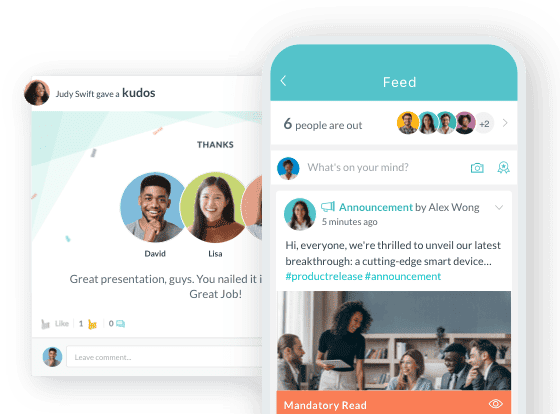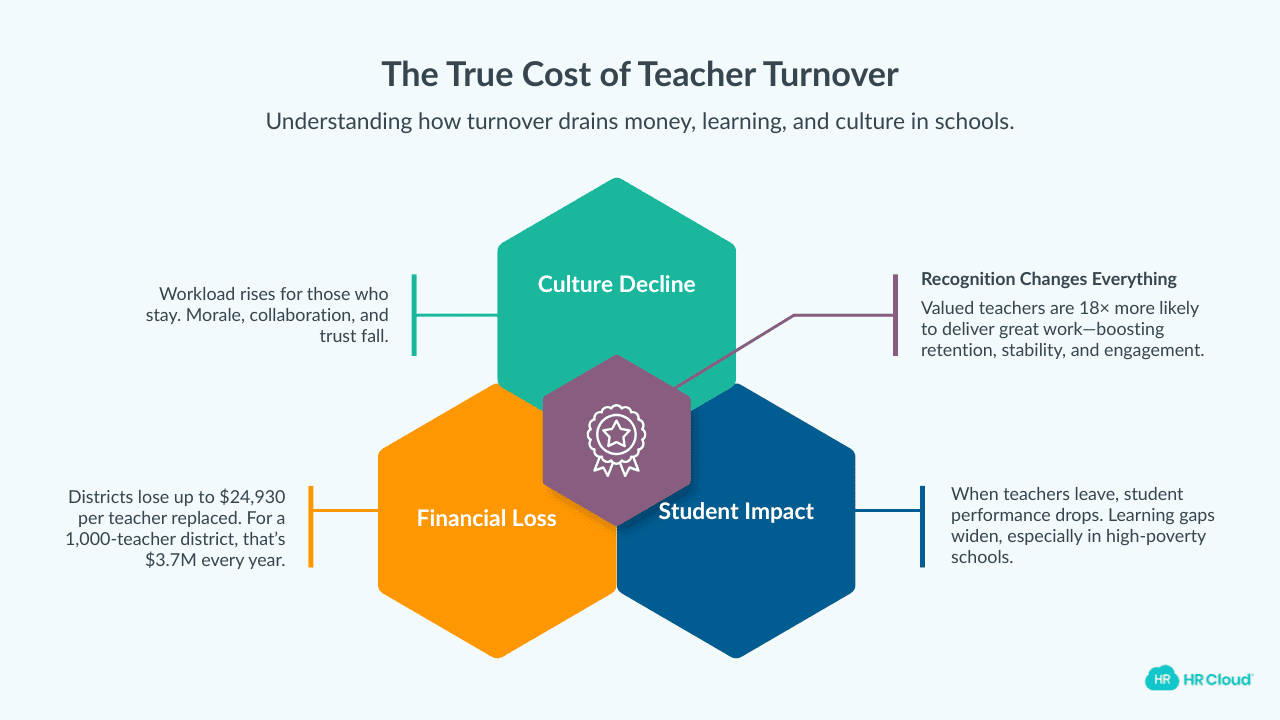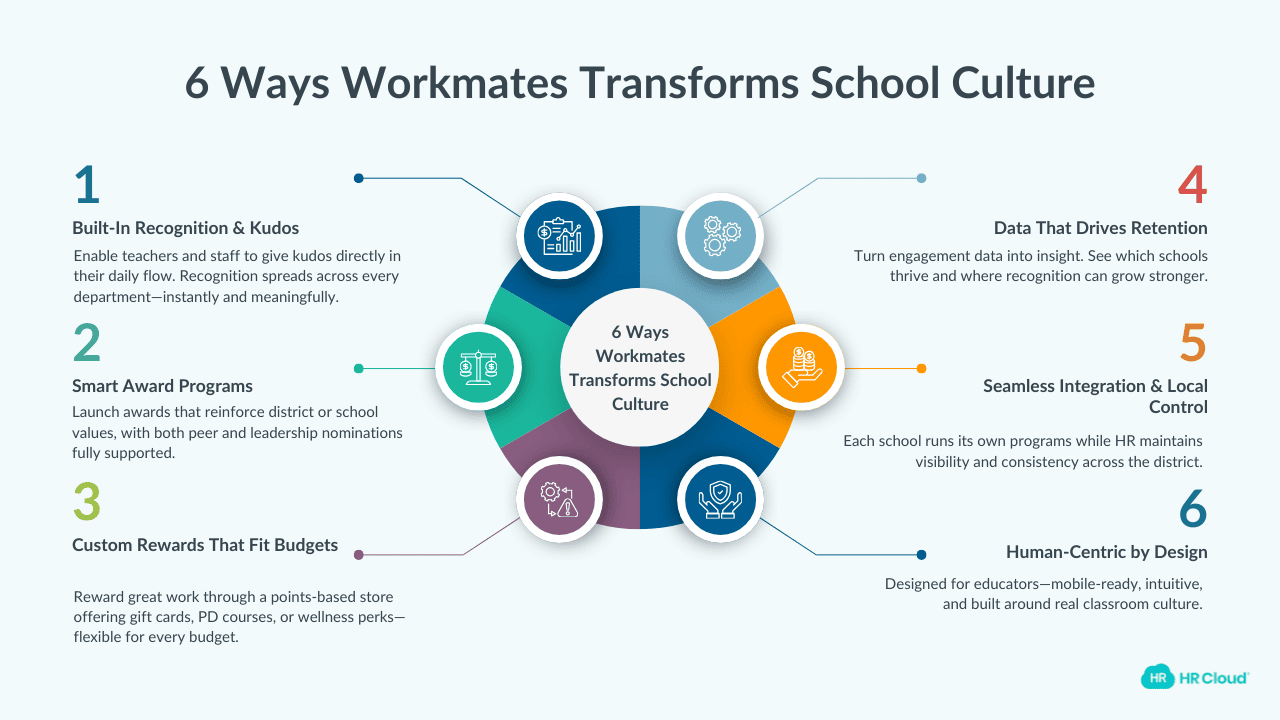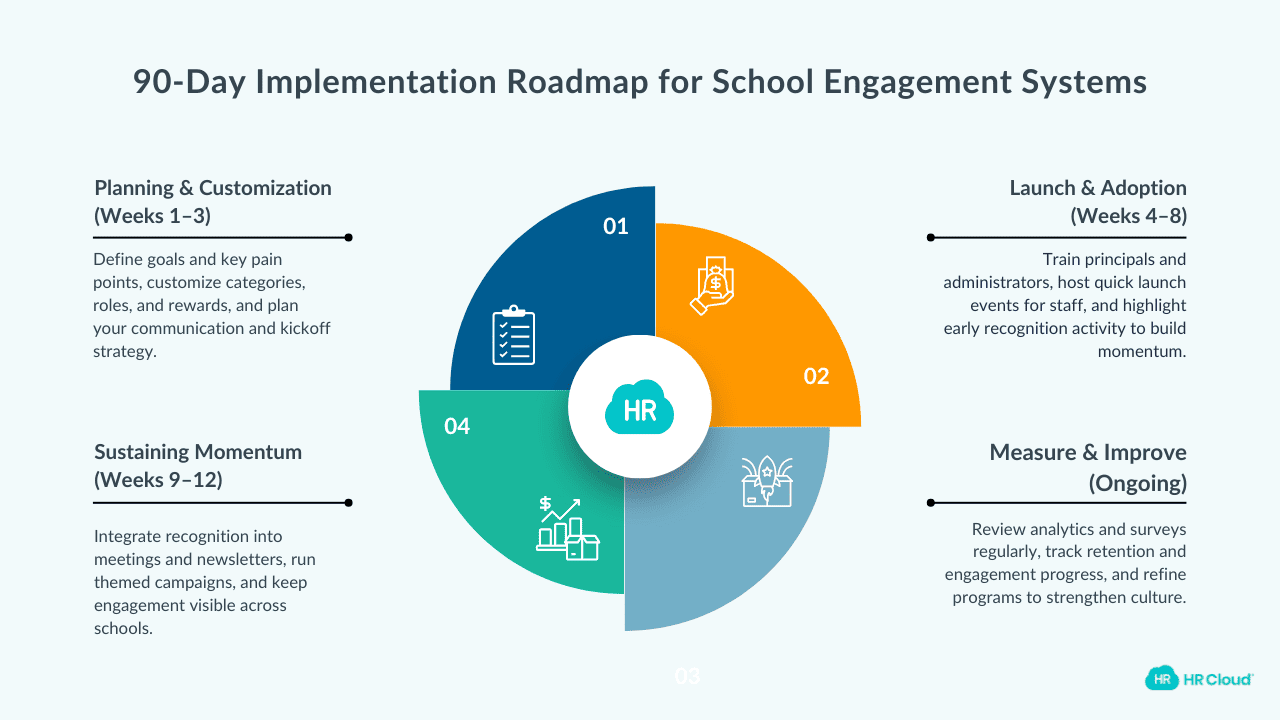Employee Recognition Software for School Staff: The Only Tool You Need For Teacher Retention
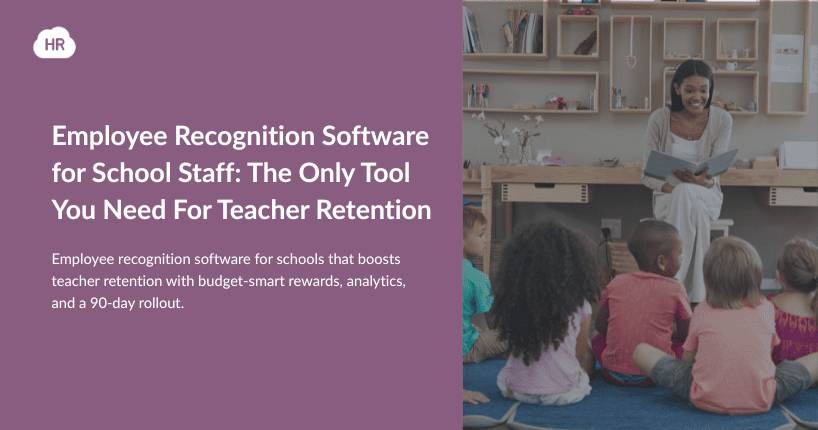
- What Your District Loses When Teachers Walk Out
- What Success in Retaining Teachers Looks Like
- Science Behind Recognition: Why It Works Even When Salaries Can't Change Fast Enough
- What Makes Recognition Different in Education
- Why Workmates is the Perfect Recognition Platform for Schools
- A Quick and Easy 90-day Implementation Guide for School Employee Engagement Systems
- The Path Forward: Make Recognition Part of Your Culture, Not Just an Initiative
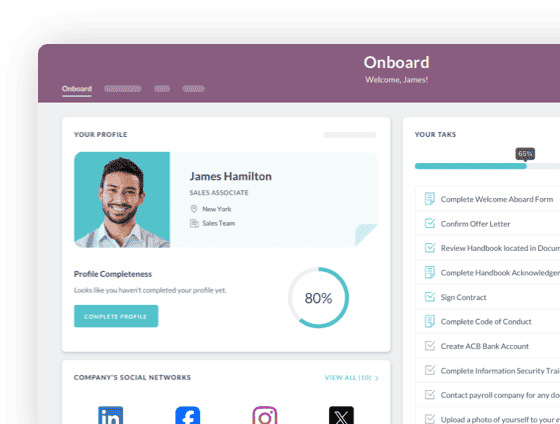
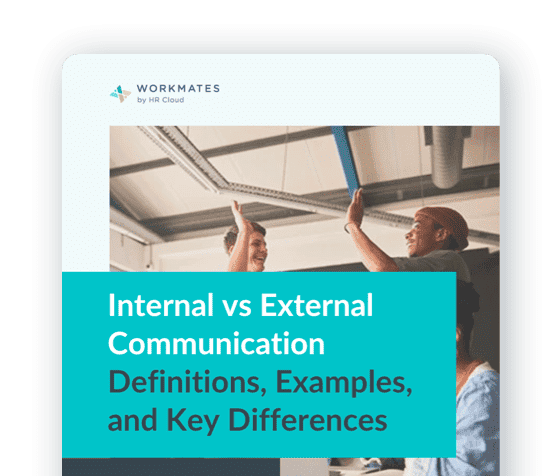
 Cut onboarding time
by 60%—here's the
Ultimate Checklist
that helped do it.
Cut onboarding time
by 60%—here's the
Ultimate Checklist
that helped do it.
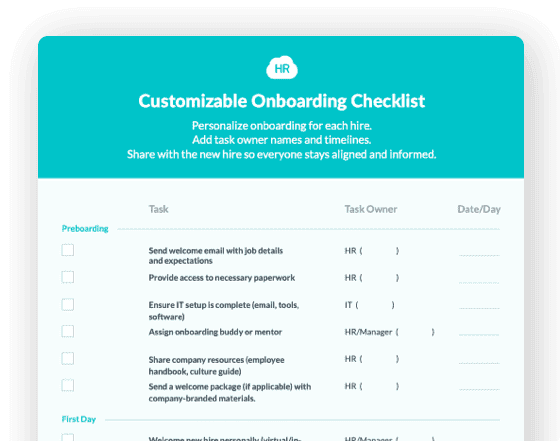
If you have been asking yourself, how to retain your teachers, you have landed at the right place.
But first, the TL;DR (to ensure we are on the same page)
School districts are witnessing talent loss at unprecedented rates. If you are a school administrator struggling with this, here are a few points for you to ponder:
-
23% of teachers left their school in 2022-23, costing districts up to $24,930 per teacher replacement.
-
Employees who receive high-quality recognition are 45% less likely to leave their jobs.
-
Most schools lack structured recognition systems, despite evidence showing companies with strong recognition cultures see 31% lower turnover rates.
-
The simplest solution is a culture of appreciation that makes educators feel valued every day.
-
Recognition software designed for educational environments can reduce turnover, combat burnout, and rebuild the sense of community that keeps great teachers in classrooms.
Is This You?
Sarah Martinez, principal of a 850-student middle school in a suburban capital city, knew something was deeply wrong when she walked the school hallways on the third Monday of September.
Room 204: substitute teacher. Ms. Johnson had resigned over summer after eight years.
Room 311: another substitute. Mr. Chen left mid-August, citing burnout.
By October, Sarah had lost five teachers. By December, seven. Her inbox overflowed with resignation emails, each containing variations of the same message:
"I love teaching, but I don't feel valued."
"No one notices the extra hours."
"I'm exhausted and invisible."
The irony haunted her.
Because these were excellent educators. She appreciated them. But in the chaos of managing 67 staff members, endless compliance requirements, and perpetual real time crisis response, showing appreciation had become the thing she'd get to "when things calm down."
Things never calmed down. And by year's end, Sarah's district had spent $178,000 replacing those seven teachers. Money that could have funded new equipment, professional development, or the art program they'd cut two years prior.
What Your District Loses When Teachers Walk Out
According to a study spanning nine large school districts across the US, on average, 23% of teachers left their school in 2022-23. But what is even more alarming is that in the same period, 30% of new recruits left as well, implying that districts lost their hiring and training investments before seeing returns.
According to the Learning Policy Institute's 2024 research:
-
Small districts (under 10,000 students) lose $11,860 per teacher replacement
-
Medium districts (10,000–50,000 students) lose $16,450 per teacher
-
Large districts (over 50,000 students)lose $24,930 per teacher
For a large district with 1,000 teachers and 15% turnover, that's $3.7 million annually & $18.7 million over five years. A figure easily comparable to entire school budgets in many districts.
When you consider that we are dealing with students here, you realise the true cost extends far beyond budgets and monetary implications. They also affect in other ways:
-
Student achievement suffers: Studies show students whose teacher leaves mid-year experience significantly lower academic gains. The instability creates learning gaps that compound year after year, particularly in high-poverty schools already fighting achievement disparities.
-
Institutional knowledge vanishes: When experienced teachers leave, they take irreplaceable expertise with them. From in-depth curriculum knowledge and student family dynamics to community relationships, and the informal systems that make schools function.
-
Those left behind struggle with increased workload: Teachers already work an average 9 more hours per week, compared with similar working adults. When colleagues leave, the rest of the teachers need to take up additional responsibilities.
-
School culture takes a beating: Overwork, stress and burnout creates an overall toxic work environment that spreads negativity, breaks down collaboration, and the sense of community erodes.
Research has further revealed that the majority of teachers find their work rewarding but they feel undervalued or unappreciated by their school communities.
Lack of recognition and acknowledgment erodes morale and contributes to feelings of disillusionment and burnout. And here's something you should know: employees that are personally recognised are 18X more likely to put in great work.
On that note, I would like you to imagine the perfect scenario when you are able to personally recognise all your teachers and other teaching roles.
What Success in Retaining Teachers Looks Like
Imagine if Sarah could have rolled this out in her school:
A sixth-grade science teacher Anne stays late Tuesday to help struggling students prep for the state assessment.
Wednesday morning, Anne receives recognition from Sarah via the school's recognition platform, which is visible to colleagues. And she accumulated more points that could be redeemed using gift cards.
As the day progressed, three colleagues added their own recognition for her collaborative spirit in last week's PLC meeting. When Anne logs in to the engagement platform during lunch, she sees a dozen notifications of appreciation, including one from a board member, and feels genuinely seen.
On the adrenalin high of appreciation, she provides further recognition to a few members of her team.
Now, the validation did not erase the exhaustion but it shifted the narrative in her head from "It is so exhausting here" to "My work matters here."
Which makes all the difference when it comes to retaining employees.
And if you thought that this is a hypothetical situation, think again. Or better still, read these statistics that emphasise that the impact of recognition on employee retention is direct:
-
Employees who received high-quality recognition on the job were 45% less likely to have left that job between 2022 and 2024.
-
Organizations with formal employee recognition programs have 31% less voluntary turnover than organizations without any program.
-
Employees who receive recognition that meets at least four pillars of strategic recognition are 9X more likely to be engaged.
-
Organizations with high employee engagement levels get 23% more profitable, 18% higher productivity, and 21% lower turnover.
When teachers feel appreciated, they connect to their purpose and recognize the impact that they are making in the students’ lives. They remember why they entered education, and more importantly, they stay.
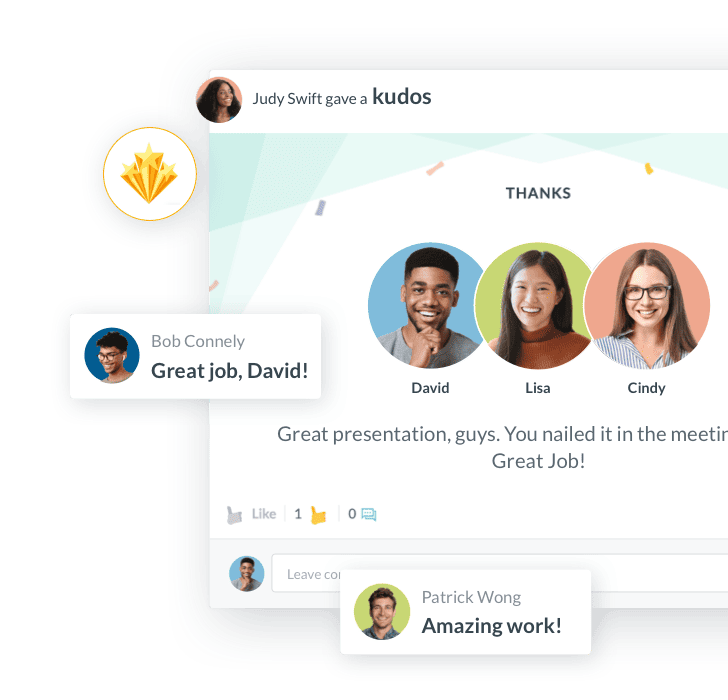
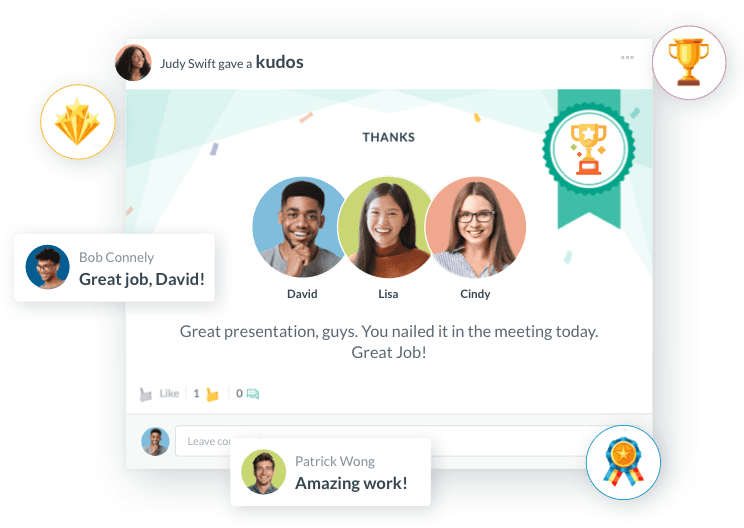
Science Behind Recognition: Why It Works Even When Salaries Can't Change Fast Enough
School administrators face a painful reality: they can't control teacher salaries. Collective bargaining agreements, state funding formulas, and budget constraints limit compensation flexibility.
But waiting for structural pay reform means accepting continued turnover hemorrhaging.
Recognition addresses a different but equally powerful human need. Neuroscientists have found that people process verbal affirmations similar to how they perceive financial rewards. When we receive authentic appreciation, the brain releases dopamine and creates positive reinforcement loops. This further strengthens desired behaviors and organizational attachment.
When employees receive recognition that satisfies even one pillar of strategic recognition, they are 2.9 times as likely to be engaged.
In case you are wondering, the five pillars of strategic recognition that drive retention are:
1. Fulfilling: Aligned with organizational values and culture
2. Authentic: Sincere and specific about the recognized behavior
3. Equitable: Available to all employees based on merit
4. Personalized: Tailored to individual preferences and contributions
5. Embedded: Integrated into regular operations, not isolated events
According to a 2024 Tyton Partners research, nearly 1 out of 5 teachers are considering leaving the profession in the next four years, but a majority are also driven to stay because of the community ties they've developed.
Recognition programs can systematically build those community ties, creating webs of appreciation that make leaving emotionally costly.
So what does recognition look like in an educational setting?
What Makes Recognition Different in Education
Corporate recognition programs fail in schools because the school environment is fundamentally different from typical business environments.
Here’s how:
-
Distributed authority structures: Schools have complex hierarchies that are needed for a smooth functioning. Think district administrators, principals, department heads, grade-level leads, and instructional coaches. So, recognition must flow multidirectionally – peer-to-peer, teacher-to-support-staff, administrator-to-teacher, even student-to-teacher in age-appropriate ways.
-
Diverse roles: Effective schools require teachers, paraeducators, custodial staff, food service workers, bus drivers, counselors, nurses, librarians, and administrative personnel. Recognition systems must honor all roles equitably, eliminating the perception that only classroom teachers matter.
-
Seasonal cycles: Unlike corporate environments with quarterly cycles, schools operate on academic calendars. They have intense periods (standardized testing, back-to-school, graduation, etc.) combined with seasonal breaks (winter break, summer). Recognition must adapt to these rhythms, increasing during high-stress periods when teachers need more support at all levels.
-
Limited budgets: Schools lack huge corporate budgets for rewards. Recognition systems must offer meaningful incentives within tight financial constraints. This can be easily achieved with creative solutions beyond expensive gift cards or merchandise, but that intent needs to be there.
-
Privacy considerations: FERPA and student privacy requirements complicate public recognition involving student outcomes. Recognition systems must celebrate educator impact without violating confidentiality.
-
Union culture: Many districts work with collective bargaining agreements that specify evaluation procedures and merit considerations. Recognition programs must work in tandem with these labor agreements.
-
Cultural heterogeneity: Individual schools within the same district often have distinct cultures. Recognition systems should have enough flexibility for school-level customization while maintaining district-wide cohesion.
Generic HR platforms designed for corporate environments can't navigate these complexities. Schools need purpose-built solutions that understand education's unique ecosystem.
Why Workmates is the Perfect Recognition Platform for Schools
When Endeavor Schools, a growing U.S. network of private K–12 institutions, began expanding across states, they faced a familiar problem: staying connected across dozens of campuses. Emails weren’t enough and key messages often missed staff without regular access to inboxes. Workmates became their solution.
Read the full Endeavor Schools case study here.
 — Andrea Bermudez, Organizational & Talent Development Manager
— Andrea Bermudez, Organizational & Talent Development Manager 

But what started as a communication upgrade soon evolved into an ecosystem for recognition, engagement, and culture building for hundreds of educators.
Why? Because Workmates is Built for Educational Environment, Not Corporate Cubicles
Unlike corporate platforms repurposed for schools, Workmates is designed around how educators actually work – fast, collaborative, and community-driven.
Built-In Recognition and Kudos
Teachers and administrators can give kudos directly within their daily workflows without having to switch tabs or extra logins. Recognition flows peer-to-peer, admin-to-teacher, or across departments, building morale through a social feed that celebrates every contributor, from front office to custodial staff.
Smart Award Programs
Principals or district HR can launch monthly or values-based awards that align with school improvement goals. Workmates supports both peer nominations and leadership recognition, with permissions tailored to district hierarchies, giving each school autonomy while preserving system-wide visibility.
Custom Rewards That Fit Budgets
Through a points-based rewards store, educators redeem recognition for practical perks: gift cards, PD opportunities, or wellness benefits. Districts set redemption thresholds and approve categories, ensuring compliance and stretching limited budgets.
Data That Drives Retention
Workmates’ analytics reveal what’s working, from recognition frequency to engagement trends by campus or role. Administrators can identify low-participation schools, track equity in recognition, and tie engagement metrics to retention outcomes.
Seamless Integration and Local Control
With role-based access, each school manages its own recognition programs while HR oversees district-wide insights. Integration with SIS and HR systems automates user management, reducing IT load and ensuring smooth implementation.
Human-Centric by Design
Built with educators’ reality in mind, Workmates works seamlessly on mobile, minimizes clicks, and speaks educators’ language — community, learning, and student success.
A Quick and Easy 90-day Implementation Guide for School Employee Engagement Systems
School districts often fear that new initiatives will add to administrator workload. If you are stuck in one such web, know this: a properly implemented recognition system reduces workload by creating a self-sustaining appreciation culture. Here’s how:
Phase 1: Planning and Customization (Weeks 1-3)
Week 1: Define Success Metrics
-
Identify current turnover rates, engagement survey results, and pain points
-
Set specific targets (e.g., "Reduce turnover from 15% to 12%")
-
Assign executive sponsor and implementation team
Week 2: Customize Platform
-
Configure recognition categories aligned with school district values
-
Set up role-based permissions for principals and administrators
-
Customize rewards storefront with budget-appropriate options
-
Brand platform with district logos and messaging
Week 3: Communication Planning
-
Develop launch messaging emphasizing "why" (culture shift, not compliance)
-
Create training materials for administrators and staff
-
Schedule kickoff events at each school building
Phase 2: Launch and Adoption (Weeks 4-8)
Week 4: Administrator Training
-
Train principals and department heads first
-
Emphasize their role in modeling recognition behaviors
-
Provide talking points for building-level rollouts
Week 5-6: Staff Rollout
-
Building-level launch events (30-minute sessions)
-
Hands-on practice giving and receiving recognition
-
Distribute quick-reference guides and support resources
Week 7-8: Activation Campaign
-
Plan for leadership to give recognition to jumpstart activity
-
Celebrate early adopters in district communications
-
Monitor participation and provide gentle nudges to inactive users
Phase 3: Sustaining Momentum (Weeks 9-12 and Beyond)
Weeks 9-12: Embed in Operations
-
Integrate recognition into staff meetings and PLCs
-
Share recognition highlights in principal newsletters, if possible
-
Run themed recognition campaigns (e.g., "Support Staff Appreciation Month")
Ongoing: Measure and Adjust
-
Monthly analytics reviews to identify engagement gaps
-
Quarterly surveys to assess cultural impact
-
Annual comparison of retention metrics against baseline
Time-to-Value
Districts typically see meaningful cultural shifts within 60-90 days of launch. Retention impacts become measurable 6-12 months after implementation as that shown effect only after recognition becomes embedded in school culture.
The key to sustainable success is an intentional top down approach. Executive involvement from the superintendent's office, principals who model recognition behaviors, and consistent communication positioning recognition as a cultural priority.
The Path Forward: Make Recognition Part of Your Culture, Not Just an Initiative
The teacher retention crisis won't resolve through policy reforms alone. Salary increases, improved benefits, and reduced class sizes matter but they arrive take time.
Recognition is the intervention you can implement right now.
Teachers are driven to stay because of the community ties they've developed. Strategic recognition systematically builds those ties—creating networks of appreciation that make school communities resilient even during challenging periods.
The research is unambiguous:
-
Employees who get meaningful recognition are 45% less likely to leave
-
Every dollar invested in recognition yields returns in engagement, productivity, and retention
Your district is spending hundreds of thousands, potentially millions, managing turnover. Those same resources invested in keeping great educators would transform school culture, stabilize learning environments, and deliver compounding returns year after year.
The question isn't whether your district can afford recognition software. It's whether you can afford to keep losing teachers who feel invisible.
Workmates helps school districts build a culture where every educator feels valued. The platform is purpose-built for education, addressing the unique challenges of distributed authority, role diversity, and budget constraints that generic HR software ignores.
Schedule a Personalized Demo Today
FAQs
What is employee recognition software for schools?
Recognition software for schools is a platform that helps districts, principals, and staff give meaningful praise, rewards, and visibility to educators and support personnel. It’s tailored to school structures—enabling peer-to-peer, leader, and cross-role recognition in a way that works around class schedules, limited budgets, and privacy constraints.
How does recognition software help reduce teacher turnover?
Recognition software makes appreciation timely, visible, and equitable—factors linked to stronger belonging and engagement. Teachers who feel recognized are significantly less likely to leave. Over time, consistent recognition can shift sentiment from “invisible” to “valued,” which helps retain experienced educators.
What features should schools look for in recognition software?
Essential features include role-based permissions (district, principal, staff), budget-controlled rewards catalogs, analytics by campus or role, integration with SIS/HR systems, and mobile access for ease of use between classes.
How much does employee recognition software cost for schools?
Pricing varies based on scale, integrations, and reward complexity. Many platforms use per-user or per-school pricing tiers. Schools should compare baseline feature sets, budget controls, and ROI potential rather than defaulting to the lowest cost.
How quickly can schools launch a recognition program?
A well-structured rollout can take 60 to 90 days: planning and customization (weeks 1–3), staff training and launch (weeks 4–8), and embedding recognition into routines (weeks 9–12). Early wins and leadership modeling help accelerate adoption.
Can recognition software integrate with existing school systems?
Yes, top platforms support integrations with school information systems (SIS), HR databases, and communication tools (e.g. newsletters, intranet). This ensures automatic user sync, single sign-on, and reduced administrative burden.
How do schools measure the success of recognition programs?
You can start with leading indicators such as recognition frequency, user participation, recognition equity by role/campus. Then connect those to outcomes: teacher retention, absenteeism changes, engagement survey scores, or cost savings from reduced turnover.

Keep Reading
75 Retirement Messages for Employees: Recognition Best Practices
Let's hear it for the retirees. They've shown up, delivered results, shaped teams, and
45 Boss Day Messages That Actually Mean Something (2026 Guide)
When is Boss Day 2026? Mark your calendar for October 16, 2026 — the annual opportunity
Birthday Wishes for Coworkers: 50+ Messages That Build Workplace Connection
A coworker's birthday isn't just another calendar date—it's a meaningful opportunity to
Like What You Hear?
We'd love to chat with you more about how HR Cloud® can support your business's HR needs. Book Your Free Demo

Build a Culture of Recognition. Boost Engagement. Guaranteed.
Workmates empowers employees to stay informed, connected, and appreciated—whether they’re on the front line, in the office, or remote. Recognition drives 12x higher engagement.Trusted by industry leaders in every sector




Cut Onboarding Costs by 60%.
Take the confusion and follow-ups out of onboarding with automated workflows, digital forms, and structured portals—so new hires ramp faster 3X quicker.Trusted by industry leaders in every sector




